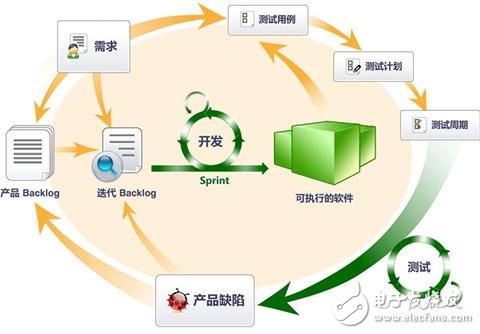What is a software test environment _ What are the software test environments? What tools are used for software testing?
Software testing refers to the process of using a manual or automatic means to run or measure a software product system. The purpose is to verify whether the specified requirements are met or to distinguish the expected results from the actual results. This article mainly describes the software testing. What are the types?
Unit test: A test for a module component or method. In my operation, it is generally the test within the scope of the developer's work; in the case of the component interface specification, it is generally necessary to do a test tool to simulate the calling environment, write a test instance, and monitor whether the module actually works normally through the breakpoint condition.
White Box Testing: Designing test cases for logical processes with an understanding of internal processes in order to identify extreme edges and inherent logic errors. The proportion of white box tests in unit tests is very high (the reason is not difficult to understand, who else understands the module's construction process more than the author himself?).

Black box test: This is the main job of the QC department. The black box test is mainly to write test cases. However, in practice, the most unskilled members are assigned to test. The highest technical level is to use VSS, so don't expect to write any test cases.
Stress test: Evaluate how much pressure a system can withstand, and the response after overload; at the same time, under extreme conditions, some bugs that usually do not appear will emerge.
Regression test; see if there is any problem with other modules after modifying one of the modules. The author believes that this test is a conceptual product of a procedural program. It is lowly coupled to each other in modular software, and obeys a unified transfer protocol. Is it true that it is a matter of home and has nothing to do with others (modules).
Overall test: After connecting the different modules, look at the joint work situation. This is actually a test of the interface protocol. The author believes that it can work as part of the design of the interactive part of the interface, and there is no need to present it as one of the processes. The same is true for system testing, anyway, what the final system is running. It seems to be big, but if the front has been done well, it is strange if there is a problem here!

What types of software testing are there? As a beginner, it is not enough to understand the type of software testing. There are a lot of tools for different types of applications. So what tools do you need to do software testing? Please see below.
What tools are used to do software testing?As the saying goes, "If you want to do something good, you must first sharpen your tools." As a qualified software test engineer, the tools used for testing must be prepared. Of course, learning how to use them is also something you must do. What tools are used for software testing? Nanjing Dana software test trainer for your detailed explanation.
Test Management Tools: Tools that help testers complete tasks such as planning, tracking, etc., and help with requirements, design, coding, and defects.
Static analysis tools: Analysis without pre-executing code is a very important defect detection tool, which measures the code with various indicators, such as McCabe measurement complexity, Logiscope measurement code and specification compounding.
Dynamic analysis tools: Analyze and evaluate the system during operation. For example, during the running process, the memory usage is checked, whether the memory is out of bounds, and whether there is a leak in the memory. Common tools include Purify and BoundChecker.
Coverage Tools: The extent to which such tools are used to execute software after the software has been executed. It is widely used in unit tests such as TrueCoverage, PureCoverage, Logiscope, and more.
Test Execution Tools: These test tools are often automated, covering unit test, integration test, system test and other requirements applications, divided into functional test automation tools: Robot, Winrunner, SilkTest, etc.; performance test tools such as Loadrunner, SilKPerformer Wait.
The tools to be used for software testing are introduced here. The above are the necessary tools for software test engineers. The black box and white box tests will also have different distinctions.

The construction of the software test environment is very important in the software test project. There are many problems that should be paid attention to. This article focuses on introducing the readers to several issues that should be paid attention to during the test process, hoping to inspire readers.
Question 1: Submit an excellent problem report
The problem report submitted by the software test is the same as the test daily report, which is the work output of the software tester and is a concentrated expression of the tester's performance. Therefore, it is important to submit a good problem report. The most critical parts of the defect report: the first part is the environment that discovers the defect, including the software environment and hardware environment; the second part is the basic description of the defect; the third part is the developer's solution to the defect. Through careful analysis of the three parts of the above defect report, the most common basic problems of software products are mastered, and the work experience of other software testers is absorbed. The most critical domain is the “problem descriptionâ€, which is the basis for developers to reproduce problems and locate problems. The problem description should include the following parts: software configuration, hardware configuration, test case input, operation steps, output, relevant output information of the output device at the time, and related logs. Software configuration: including operating system type and patch version, current tested software version and patch version, related supporting software, such as database software version and patch version.
Hardware configuration: The configuration of the computer mainly includes the relevant parameters of the CPU, memory and hard disk. Other hardware parameters are added according to the actual situation of the test case. If the network is used in the test, the networking of the network, the capacity of the network, and the traffic. The hardware configuration is closely related to the type of product being tested. It is necessary to accurately and accurately record the hardware configuration according to the current situation. Test Case Input\Operating Steps\Output: This part can be filled in according to the description of the test case and the actual execution of the test case. Output information of the output device: The output device includes a computer monitor, a printer, a tape, and the like. If the display can capture the screenshot at the time, the video can be recorded, and other output devices can use other methods to obtain related information. Output, which is described in the problem report.
Log information: The software product of the specification will provide the running log of the software and the operation log of the user and the administrator. The tester should submit the running log and operation log of the software product after the execution of the test case as an attachment to the problem report.

Test result analysis
After the execution of the software test, the test activity has not ended. Analysis of test results is indispensable ring section, "basketry knitting basket, all in shut", the analysis of the test results have major implications for the next round of testing. In the previous "Test Preparation", it is recommended that testers walk through the defect tracking library to check for software defects found by other testers. After the test is over, you should also analyze the software defects you have discovered. You can find that the defects you have submitted are only fixed in a few categories. Then, the problems discovered by other testers who have completed the test execution work are also Put together, you will find that the categories of questions you submit are different from them. This is normal. People's thinking is limited. In the process of testing, each tester has his own blind spots for thinking about problems and blind spots for test execution. Effective self-analysis and analysis of other testers, you will find your own. Blind areas, targeted analysis of blind spots, will certainly be used in the next round of testing to avoid blind spots. Setting up a test environment in the context of building a software test environment and developing a test case is the first step. Generally speaking, after the software product is submitted for testing, the developer should submit a product installation guide, which specifies the software and hardware environment in which the software product runs. For example, the operating system is required to be the Windows 2000 pack4 version, and the database is Sql Server. 2000 and so on. In addition, detailed installation instructions for the tested software product should be given, including the installation steps, configuration methods for related configuration files, and so on. For complex software products, especially software projects, if there is no installation guide as a reference, there will be various problems in the process of setting up the test environment. If the developer refuses to provide relevant installation instructions and encounters problems in the setup test, the tester can ask the developer for assistance. At this time, it is necessary to record the developer's solution to the problem and avoid the same problem. This will inevitably arouse the developer's dislike and reduce the developer's acceptance of the tester.
Question 2: Comprehensive observation test case execution results:
During test execution, can the test case be considered successful when the actual output of the test is consistent with the expected output in the test case? The answer is no, even if the actual test results are consistent with the expected results of the test, you should also check the operation log, system operation log and system resource usage of the software product to determine whether the test case is executed successfully. A full range of observations of the output of software products can reveal many hidden problems. Previously, when I was testing embedded system software, after executing a test case, the actual output of the test case was exactly the same as the expected output. However, when the CPU usage was queried, the CPU usage was found to be as high as 90%. Later, after analysis, When the software is running, several 1ms timers are started, a large amount of CPU resources are consumed. Later, by adjusting the timer to 10ms, the CPU usage is reduced to 7%. If the observation point is single, the problem of serious resource consumption will not be discovered.

Question 3: Strengthen the test process record:
During the test execution, it is necessary to strengthen the test process record. If the test execution steps are different from those described in the test case, be sure to record them as the basis for updating the test cases in the future; if the software product provides log functions, such as software run logs and user operation logs, it must be in each test case. After execution, the relevant log files are recorded as a test process record. Once problems are discovered in the future, developers can use these test records to conveniently locate the problem. Instead of having the tester rebuild the test environment, reproduce the problem for the developer.
Question 4: Confirm the problems found in time:
During the test execution, if you find that the software is found to be defective, you can submit a problem report without hesitation. If you find a suspicious problem and you are unable to locate whether it is a software defect, then you must keep the site and then inform the relevant developers to locate the problem. If the developer can confirm whether it is a software defect in a short time, the tester will cooperate; if the developer needs to take a long time to locate the problem, the tester should not delay the valuable test execution time, so that the developer can record Reproduce the test environment configuration of the problem, then return to your development environment to reproduce the problem and continue to locate the problem.
Question 5: Relationship handling with development when submitting defects:
During the test execution, when you submit a problem report, you may be ruthlessly rejected by the developer and refuse to modify. At this time, developers can only be reasonable, reasonable, convincing and persuasive. First, define the standard principles of software defects. This principle should be recognized by both developers and testers. If there is no common recognition principle, the dispute between developers and testers will be inevitable. In addition, before the testers intend to convince the developers, consider whether they can convince themselves and start communicating with the developers on the premise that they can convince themselves.

Question 6: Update test cases in a timely manner
During the test execution, you should pay attention to updating the test cases in time. Often during the test execution process, it is found that some test cases are omitted. This time should be supplemented in time; often, some test cases are not operational at all during the specific execution process. This part of the use case should be deleted at this time; Several redundant test cases can be completely replaced by one test case, then redundant test cases are removed. In short, it is a good practice to update test cases in a timely manner during test execution. Don't plan to test
After the end of the line, the test cases are uniformly updated. If so, many test cases that should be updated are often missed.
Kadena public chain is the world's first and only Layered -1 PoW blockchain that can be segmented and extensible.
Through its unique "fragmented multi-chain structure", it achieves the following characteristics:
Security. Thanks to Bitcoin's proven economic model, millions of miners defend the assets on the chain
Scalable. Performance breakthroughs are achieved by infinitely increasing parallel Bitcoin-like blockchains
Many chain structure
Going back to what users are concerned about, when you use the Kadena public chain:
There's no need to wait. Up to 480,000TPS transaction processing speed, helping you achieve "second to second transfer"
There is no need to pay high fees. Benefit from the superior expansion performance, your commission fee can be as low as 0.1 yuan or even free!
Not only that, but Kadena's powerful Pact smart contract provides developers with an extremely convenient and creative research and development tool, which is driving the development of blockchain applications at a very low barrier to entry to truly reach a large number of users.
Kadena Mining Machine:Bitmain Antminer KA3 (166Th),Goldshell KD Max,Goldshell KD6,iBeLink BM-K1 Max,
Goldshell KD6-SE,Goldshell KD Lite
Kadena Mining Machine,Goldshell Kd5,KD Box pro,ibelink bm k1 max miner,goldshell kd6
Shenzhen YLHM Technology Co., Ltd. , https://www.hkcryptominer.com
